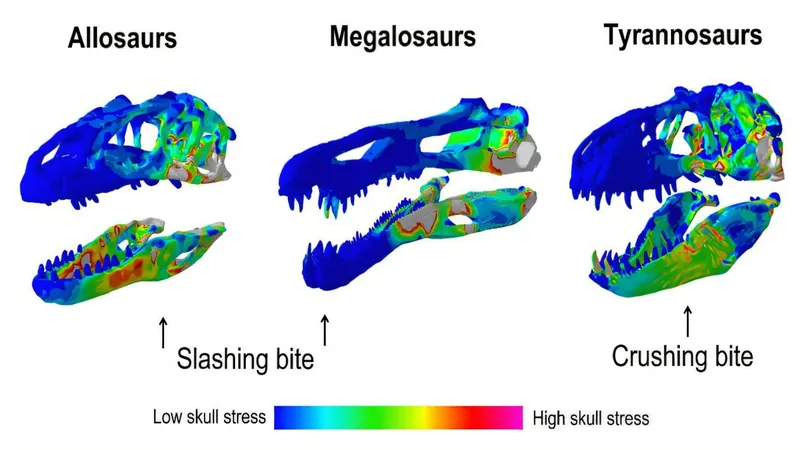
Unveiling the Surprising Truth: Not All Giant Dinosaurs Had Bone-Crushing Bites!
2025-08-04
Author: Michael
A Jaw-Dropping Discovery About Carnivorous Dinosaurs
Recent research has shattered the stereotype that all gigantic meat-eating dinosaurs were equipped with bone-crushing bites. A groundbreaking analysis of 18 carnivorous dinosaur species revealed a surprising variance in skull structure and bite strength. While the infamous Tyrannosaurus rex boasted a robust skull designed for powerful, quick bites—akin to that of modern crocodiles—other formidable predators like spinosaurs and allosaurs were found to possess significantly weaker bites geared more towards slashing and tearing flesh.
The Evolution of Feeding Strategies Unveiled
This fascinating study, published in Current Biology, highlights how these colossal carnivores evolved diverse feeding mechanisms despite their gigantic sizes. Andrew Rowe from the University of Bristol explains, "Carnivorous dinosaurs took various evolutionary paths, leading to distinct feeding biomechanics and behaviors. Tyrannosaurs favored strength and crushing bites, while other lineages developed weaker but specialized skull designs. This diversity in feeding strategies suggests there wasn't just one optimal design for being a predatory giant; multiple designs thrived effectively."
Intriguing Insights from the Prehistoric World
Rowe, with co-author Emily Rayfield, aimed to explore how bipedalism—the ability to walk on two legs—affected these dinosaurs' skull mechanics and feeding techniques. Although it was known that large predatory dinosaurs emerged independently across different regions and eras, the extent of their functional similarities—and differences—remained unclear. With no massive bipedal carnivores existing today, this study offers a rare glimpse into a vanished lifestyle.
Revolutionary 3D Analysis Reveals Surprising Findings
Using cutting-edge 3D technologies, including CT and surface scans, the researchers meticulously analyzed the skull mechanics, feeding performance, and bite strength of these theropods. The results were astonishing; instead of the expected minor variations between species, distinct biomechanical divergences were unveiled. Rowe noted that while T. rex’s skull was tailored for high bite forces, other giants like Giganotosaurus displayed stress patterns indicative of a lighter bite, emphasizing the myriad evolutionary solutions available to large carnivorous bipeds.
Beyond Size: The Complexity of Dinosaur Predation
Intriguingly, skull stress didn't uniformly escalate with size. In fact, some smaller theropods experienced greater stress than their more massive counterparts, owing to larger muscle volume and bite forces. This insight reveals that being a predatory biped didn’t automatically translate to being a fearsome bone-crushing giant. Unlike the T. rex, dinosaurs like spinosaurs and allosaurs flourished while maintaining weaker bites, exclusively adapted for ripping and tearing flesh.
A Window into the Unique Ecosystem of Giants
Rowe likens the feeding style of Allosaurus to that of a modern Komodo dragon, contrasting it sharply with the crushing capabilities of large tyrannosaurs. This biomechanical diversity paints a vivid picture of dinosaur ecosystems as being home to a broad spectrum of giant carnivore ecologies—suggesting less competition and greater specialization than previously assumed. Understanding these intricate dynamics is like unlocking a secret chapter in the ancient history of our planet!









 Brasil (PT)
Brasil (PT)
 Canada (EN)
Canada (EN)
 Chile (ES)
Chile (ES)
 Česko (CS)
Česko (CS)
 대한민국 (KO)
대한민국 (KO)
 España (ES)
España (ES)
 France (FR)
France (FR)
 Hong Kong (EN)
Hong Kong (EN)
 Italia (IT)
Italia (IT)
 日本 (JA)
日本 (JA)
 Magyarország (HU)
Magyarország (HU)
 Norge (NO)
Norge (NO)
 Polska (PL)
Polska (PL)
 Schweiz (DE)
Schweiz (DE)
 Singapore (EN)
Singapore (EN)
 Sverige (SV)
Sverige (SV)
 Suomi (FI)
Suomi (FI)
 Türkiye (TR)
Türkiye (TR)
 الإمارات العربية المتحدة (AR)
الإمارات العربية المتحدة (AR)